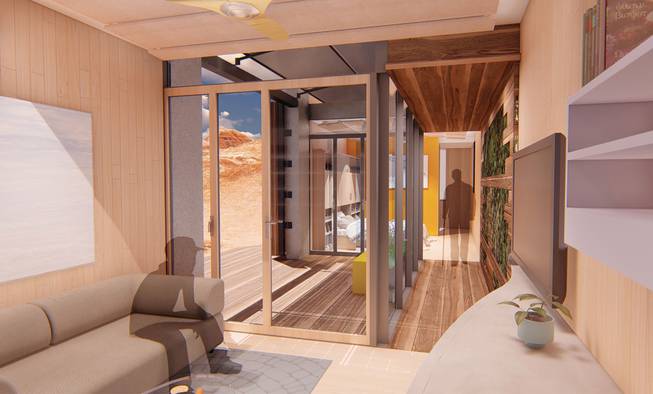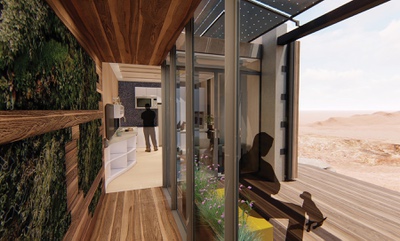
Courtesy
UNLV’s latest Solar Decathlon project, called Desert Bloom, will be designed to help veterans with post-traumatic stress disorder (PTSD) return to civilian life.
Saturday, Jan. 25, 2020 | 2 a.m.
Not so long ago, when the world was still analog, architecture students came into college already having some experience building things. Previous generations took shop classes or tinkered in their parents’ garage. Today, students possess excellent computer skills, but they are less likely to have a tangible connection to the physical world, according to UNLV associate professor of architecture Eric Weber.
“I took multiple shop classes when I was in high school, just for fun,” Weber says. He learned welding, carpentry and metalworking. “It’s had a profound impact on the work that I did.”
Weber says a generation of educators didn’t see the value in such real-world skills, so his students come in with very little hands-on education. “It makes it hard for them to design these complex systems and buildings.”
But in 2011, UNLV created a solution by opening its Design-Build program. This year, the program is dedicated to one major project: competing in the Solar Decathlon. Hosted by the Department of Energy, it’s an international interdisciplinary competition in which groups design and build state-of-the-art solar-powered eco houses.
UNLV has participated twice in the past to great success. Weber proudly recalls that all of the architecture students who took part in the 2013 Solar Decathlon found jobs right away, even though the industry was facing close to 45% unemployment.
Weber sees Solar Decathlon as a way to develop cross-campus connections and put UNLV on the map. He’s still thrilled about UNLV’s 2013 debut, in which the school finished second overall and was the only U.S. team to finish in the top three. “It was our first time, and we beat Stanford, USC, Arizona. … That illustrated that not only can we compete with the best in the industry, [but] our students are capable of anything.”
When UNLV competed again in 2017, the team took first place for innovation and placed second for both engineering and architecture.
Now, an interdisciplinary team of UNLV students and faculty is preparing for Solar Decathlon 2020. They started the project last fall, and it will culminate in a July competition on the National Mall in Washington, D.C.
Solar Decathlon’s limited time frame fosters a sense of energy; it’s a catalyst for innovation and discovery, according to Weber. “The students benefit tremendously from doing these real-world projects,” Weber says. “They learn so many skills. In addition to their own disciplines, they learn to work across disciplines with each other, [and that] communication is essential to doing good work.”
Scott Davis, who graduated in May with a master’s degree in architecture, says he uses skills learned in Solar Decathlon “every single day” in his job as a project manager at FormGrey Studio in Reno.
Ryan Manthei, Solar Decathlon team lead and a first-year graduate student in architecture, says he enjoys connecting with the larger university community. “We have engineering students working with us; we have an interior designer, landscape architects. We have even graphic designers. We’ve been working with the School of Hospitality to prepare a meal for the contest.”
A flower in the desert
When embarking upon a Solar Decathlon project, a team must first choose a fictional client or target market. Who will live in this sustainable solar-powered house of the future? The 2013 house, known as DesertSol and now on display at Springs Preserve, was designed for Mojave Desert dwellers. The 2017 house, called Sinatra Living, was designed with retirees in mind. It featured adjustable countertops to accommodate wheelchairs, slip-resistant flooring, fall-detection sensors and more.

Every aspect of Desert Bloom has been conceived to promote a sense of shelter and serenity, both physically and metaphorically. For example, the team is at work on a large exterior sliding gate dotted with plants. Not only will it be pretty, it will allow the resident to see out without being seen, an important research-backed amenity for those with PTSD.
UNLV’s latest Solar Decathlon project, called Desert Bloom, will be designed to help veterans with post-traumatic stress disorder (PTSD) return to civilian life. The initial team included several veterans, some of whom had served in Iraq and Afghanistan.
“Our project has a real gravitas because of that,” says Weber, who served in the Marines. “By understanding how one responds to these unique challenges, we can train better designers.”
The house will be displayed in Washington, D.C., from June 25-July 5 and must be designed to withstand the 2,400-mile road trip there, along with fulfilling traditional building code specifications. To fit on a vehicle, the house will be long and narrow—but don’t expect it to feel like a mobile home. That’s the opposite of the project’s goal.
The UNLV team is utilizing the cutting edge of clean tech. Desert Bloom will be fully solar-powered, capable of running off-grid whether or not the sun is out. A solar-thermal array will heat the water, even on cloudy days. High-efficiency radiant piping will heat the house in winter without drying people’s skin (as opposed to air heaters, which do).
“All of the technologies we’re using have to be currently available,” Weber says. “[It’s] not science fiction.”
Desert Bloom is also designed to flourish in the harsh desert climate. There will be no synthetic materials on the exterior, because those would degrade under ultraviolet rays. Instead of paint, which fades under the sun, the team chose a galvanized metal exterior that will act as a heat shield, keeping the interior cool while preventing the heat-island effect that plagues the Vegas Valley. And true to its name, Desert Bloom will be landscaped with native desert plants.
Veteran vision
Ultimately, a successful home is often one in which the fancy stuff disappears and the resident can get down to living in a beautiful environment that just works. That’s even more important when designing for veterans.
Every aspect of Desert Bloom has been conceived to promote a sense of shelter and serenity, both physically and metaphorically. For example, the team is at work on a large exterior sliding gate dotted with plants. Not only will it be pretty, it will allow the resident to see out without being seen, an important research-backed amenity for those with PTSD.
Similarly, the courtyard will be all glass, allowing a resident to see through the entire house at a glance. If residents can quickly assess threats, it can help reduce their stress level. Thickened walls provide a barrier against noises that can be triggering. The interior uses matte finishes to prevent glare that could cause an adverse reaction, according to architecture professor Dak Kopec, who specializes in person-centered design.
“When you work with people who have dementia or traumatic brain injuries, you’ve got to be very careful of optical illusions,” says Kopec, who’s helping with the Solar Decathlon project. “What the eyes see may be interpreted incorrectly by the brain. So we want to use solid materials or big, thick patterns.”
Solar Decathlon has nudged Manthei’s interests in a new direction. “It has helped me realize that there’s really no excuse for making wasteful buildings anymore,” he says. “We have the technology, it’s not more expensive.”
Manthei sees his hometown as the perfect laboratory for creating a more sustainable built environment. “Las Vegas is such a dynamic city,” he says.
He envisions future sustainable cities featuring higher density, greater walkability, less sprawl and more mixed-use spaces. “Las Vegas is a place where people are open to new ideas,” Manthei says. “I would really like to be a part of that change coming out of school.”
This story appeared in Las Vegas Weekly.
